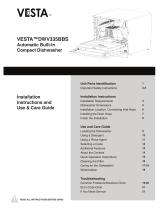
Only authorised personnel should carry out
servicing. (Certificate o
f Compliance to be
retained)
Always ensure the appliance is switched off
before cleaning or replacing parts.
THIS APPLIANCE MUST BE EARTHE
D.
To maintain safe operation, it is recommended
that the product be inspected every five years by
an authorised service person.
During installation, the power supply must not be
excessively or dangerously bent or flattened.
Do not tamper with controls.
The appliance is to be connected to the water
mains using new hose sets, and the old hose-sets
should not be reused.
Never use a spray cleaner to clean the door panel,
it could damage the door lock and electrical
components.
Do not use the abrasive agent or some pape
r
towel because of the risk of scratching or leaving
spots on the stainless steel surface.
The appliance
Do not opera
te your dishwasher unless all
enclosure panels are properly in place. Open the
door very carefully if the dishwasher is operating.
There is a risk of water squirting out.
When loading items to be washed:
- Locate sha
rp items so that they are not likely to
damage the door seal;
- Load sharp knives with the handles up to reduce
the risk of cut-type injuries;
Warning: Knives and other utensils with sharp
points must be loaded in the basket
with their
points down or placed in a horizontal position.
When using your dishwasher, you should prevent
plastic items from contacting with heating
element.
Check that the detergent receptacle is empty af
ter
completion of the wash cycle.
Do not wash plastic items unless they are marked
dishwasher safe or the equivalent. For plastic
items not so marked, check the manufacturer's
recommendations.
Use only detergent and rinse additives designed
for an automatic dishwasher. Never use soap,
laundry detergent, or hand washing detergent in
your dishwasher.
Other means for disconnection from the supply
must be inco
rporated in the fixed wiri
ng with at
least 3mm contact separation in all poles.
Dishwasher detergents are strongly alkaline. They
can be extremely dangerous if swallowed.
The door should not be left in the open position
since this could present a tripping hazard.
To avoid an accident, ensure that the appliance
shelves and fittings are always inserted into the
appliance in accordance with the instructions.
Do not use the door as a shelf.
Do not push down when the appliance doo
r is
open.
Indoor use only.
Environmental Hints
Packaging material could be dangerous for
children!
For disposing of package and the appliance
please go to a recycling centre. Cut off the power
supply cable and make the door closing device
unusabl
e.
Cardboard packaging is manufactured from
recycled paper and should be disposed in the
waste paper collection for recycling.
By ensuring this product is disposed of correctly,
you will help prevent potential negative
consequences for the environment and human
health, which could otherwise be caused by
inappropriate waste handling of this product.
For more detailed information about recycling of
this
product, please contact your local city office
and your household waste disposal service
This product must not be disposed together with
domestic waste. This product has to be disposed
at an authorised place for recycling of electrical
and electronic appliances.
By collecting and recycling waste,
you help save natural resources, and
make sure the product is disposed in
an environmental friendly and
healthy way.
3




















